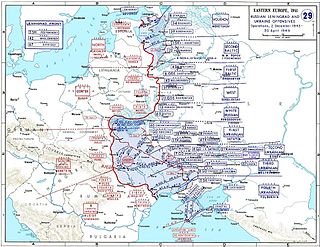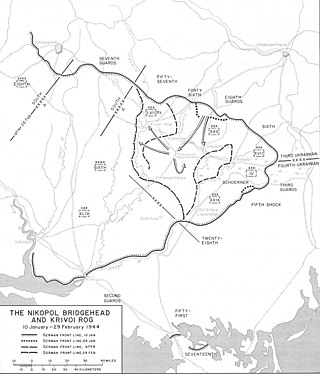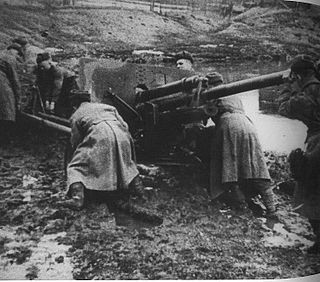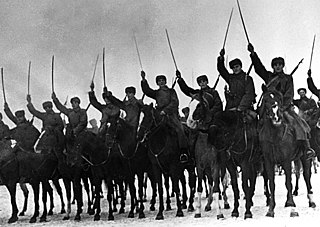
Operation Bagration was the codename for the 1944 Soviet Byelorussian strategic offensive operation, a military campaign fought between 22 June and 19 August 1944 in Soviet Byelorussia in the Eastern Front of World War II, just over two weeks after the start of Operation Overlord in the west. It was during this operation that Nazi Germany was forced to fight simultaneously on two major fronts for the first time since the war began. The Soviet Union destroyed 28 of 34 divisions of Army Group Centre and completely shattered the German front line. The overall engagement is the largest defeat in German military history, with around 450,000 German casualties, while 300,000 other German soldiers were cut off in the Courland Pocket.

The Second Battle of Kiev was a part of a much wider Soviet offensive in Ukraine known as the Battle of the Dnieper involving three strategic operations by the Soviet Red Army and its Czechoslovak units and one operational counterattack by the Wehrmacht, which took place between 3 November and 22 December 1943.

The 3rd Ukrainian Front was a Front of the Soviet Red Army during World War II.

The Battle of the Dnieper was a military campaign that took place in 1943 on the Eastern Front of World War II. Being one of the largest operations of the war, it involved almost four million troops at one point and stretched over a 1,400 kilometres (870 mi) front. Over four months, the eastern bank of the Dnieper was recovered from German forces by five of the Red Army's fronts, which conducted several assault river crossings to establish several lodgements on the western bank. Kiev was later liberated in the Battle of Kiev. 2,438 Red Army soldiers were awarded the title Hero of the Soviet Union for their involvement.

The second Smolensk operation was a Soviet strategic offensive operation conducted by the Red Army as part of the Summer-Autumn Campaign of 1943. Staged almost simultaneously with the Lower Dnieper Offensive, the offensive lasted two months and was led by General Andrei Yeremenko, commanding the Kalinin Front, and Vasily Sokolovsky, commanding the Western Front. Its goal was to clear the German presence from the Smolensk and Bryansk regions. Smolensk had been under German occupation since the first Battle of Smolensk in 1941.

The Dnieper–Carpathian offensive, also known in Soviet historical sources as the Liberation of Right-bank Ukraine, was a strategic offensive executed by the Soviet 1st, 2nd, 3rd, and 4th Ukrainian Fronts, along with the 2nd Belorussian Front, against the German Army Group South, Army Group A and elements of Army Group Center, and fought from late December 1943 to early May 1944. The battles in right-bank Ukraine and in the Crimea were the most important event of the 1944 winter-spring campaign on the Eastern Front.

The Zhitomir–Berdichev offensive operation was a part of the strategic offensive of the Red Army in the right-bank Ukraine, the Dnieper–Carpathian offensive. The successful offensive operation was conducted by the forces of the 1st Ukrainian Front commanded by General of Army Nikolai Vatutin during World War II, from 24 December 1943 through to 14 January 1944.

The Donbas strategic offensive was the second of two strategic operations of the Soviet Red Army on the Eastern Front of World War II, with the goal of liberating the Donetsk Basin, or Donbas, from the forces of Nazi Germany.

The Nikopol–Krivoi Rog offensive was an offensive by the Red Army's 3rd Ukrainian Front and elements of the 4th Ukrainian Front against the German 6th Army in the area of Nikopol and Krivoi Rog in Dnipropetrovsk Oblast in central Ukraine between 30 January and 29 February 1944. It took place on the Eastern Front of World War II and was part of the wider Dnieper–Carpathian offensive, a Soviet attack against Army Group South to retake the rest of Ukraine that fell to Germany in 1941.
The 315th Rifle Division was a standard Red Army rifle division formed for the first time on February 12, 1942, in the Siberian Military District before being sent to the vicinity of Stalingrad, where it was engaged in the futile efforts to break through to the besieged city from the north near Kotluban. After rebuilding, it was part of the southern thrust of Operation Uranus in November, helping to encircle the German 6th Army and also to hold off its would-be rescuers. During 1943 and early 1944 the division advanced through the southern Donbas and into Ukraine, where it was honored for its role in the liberation of Melitopol, before taking part in the liberation of the Crimea in April and May 1944. The men and women of the 315th ended their war on an anticlimactic note, serving for the last year as part of the garrison of the Crimea. However, the unit, and its successors, continued to serve well into the postwar era.
The 333rd Rifle Division began forming in the North Caucasus Military District in August, 1941, as a standard Red Army rifle division, as part of the massive mobilization of reserve forces very shortly after the German invasion. In 1942 it served in the late winter and early spring fighting near Kharkov, taking a beating both then and during the opening stages of the German summer offensive. Withdrawn into the reserves, the division was rebuilt in time to take part in the Soviet counteroffensive at Stalingrad in November, and played an important role in driving the German forces out of the Caucasus region during the winter. In the autumn of 1943 the division shared credit with the 25th Guards Rifle Division for the liberation of Sinelnikovo in the Dnipropetrovsk Oblast, receiving that place name as an honorific. After battling through Ukraine and into the Balkan states, the 333rd completed its combat path on a relatively quiet note doing garrison duties in the Balkans.

The 346th Rifle Division began forming in late August, 1941, as a standard Red Army rifle division, in the Volga Military District. It was assigned to the 61st Army while both it and its Army continued to form up before moving to the front lines in December to take part in the winter counteroffensive south of Moscow. In September, 1942, it became part of the 5th Tank Army, and joined the offensive that encircled German Sixth Army at Stalingrad during Operation Uranus. During 1943 and early 1944 it continued to serve in the southern part of the front, taking part in the liberation of Crimea, before being transferred to the Baltic States region, serving in Latvia and Lithuania until February, 1945, when it was once again reassigned, this time to be part of the follow-on forces in the conquest of eastern Germany. The division ended the war with a distinguished service record, but was disbanded shortly after the German surrender.
The 347th Rifle Division began forming in mid-September 1941, as a Red Army rifle division, in the North Caucasus Military District. It was soon assigned to the 58th Army while both it and its Army continued to form up before entering combat in November, as part of the offensive that first liberated Rostov-on-Don. During the German summer offensive in 1942 the division retreated back into the Caucasus, fighting to defend the routes to the oil fields at Baku, until the German forces began to retreat after their defeat at Stalingrad. During 1943 and early 1944 it continued to serve in the southern part of the front, taking part in the liberation of Crimea, before being transferred to the Baltic States region, serving in Latvia and Lithuania for the duration of the war, compiling a distinguished record of service along the way. In 1946 it was reformed as a rifle brigade, and its several successor formations remained part of the Red Army until 1959, when it was finally disbanded.

The Bereznegovatoye–Snigirevka offensive was an offensive operation conducted in southern Ukraine by the Soviet 3rd Ukrainian Front against the German 6th Army and Romanian 3rd Army of Army Group A, in March 1944. It was part of the second stage of the strategic Dnieper-Carpathian Offensive.
The 50th Guards Rifle Division was an elite infantry division of the Red Army during World War II that continued as part of the Soviet Army during the early period of the Cold War. Converted into the 50th Guards Motor Rifle Division in the late 1950s, the division was based in Brest, Belarus. After the dissolution of the Soviet Union, the division became part of the Belarusian Ground Forces and was reduced to a brigade and then a storage base before being disbanded in 2006.
The 118th Rifle Division was thrice formed as an infantry division of the Red Army, first as part of the prewar buildup of forces. The first formation was based on the shtat of September 13, 1939. It was based at Kostroma through its early existence. After the German invasion in June 1941 it was rushed to the front as part of the 41st Rifle Corps and arrived at the Pskov Fortified Area between July 2–4. Under pressure from the 4th Panzer Group the division commander, Maj. Gen. Nikolai Mikhailovich Glovatsky, requested permission on July 8 to retreat east across the Velikaya River. There is some question if he received written orders and in any case the retreat fell into chaos due to a prematurely-blown bridge. Glovatskii was arrested on July 19, sentenced to death a week later and shot on August 3. The battered division had by then moved north to Gdov and came under command of 8th Army but could not be rebuilt due to a lack of replacements and on September 27 it was disbanded.
The 88th Guards Rifle Division was reformed as an elite infantry division of the Red Army in April 1943, based on the 1st formation of the 99th Rifle Division, and served in that role until after the end of the Great Patriotic War. It would become one of the most highly decorated rifle divisions of the Red Army.
The 96th Guards Rifle Division was reformed as an elite infantry division of the Red Army in May 1943, based on the 2nd formation of the 258th Rifle Division, and served in that role until after the end of the Great Patriotic War. It would become one of the more highly decorated rifle divisions of the Red Army.

1st Guards Cavalry Zhytomyr Red Banner Corps was a military unit of the Soviet Red Army which was renamed from the 2nd Cavalry Corps. Led by Pavel Belov it was involved in several colossal combat operations during the Great Patriotic War, with its most stupendous accomplishments seen during the Battle of Moscow.
The Kalinkovichi–Mozyr Offensive Operation was an offensive operation of the Soviet troops of the Belorussian Front in the Great Patriotic War.












